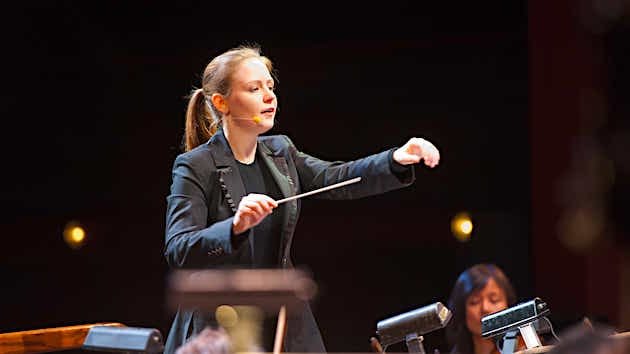Taste of New Zealand from NSO, conductor Gemma New

With a new year come new horizons. For the first subscription concerts by the National Symphony Orchestra in 2020, the novelty was evident even in the name of the guest conductor.
Gemma New, the 33-year-old New Zealand-born music director of the Hamilton Philharmonic Orchestra in Canada, made an auspicious NSO debut Thursday night in the Kennedy Center Concert Hall. It was also a homecoming of sorts, as New completed graduate studies at the Peabody Institute in Baltimore.
New brought an intriguing work by an even younger New Zealander to open the program. The New Zealand National Youth Orchestra premiered Salina Fisher’s programmatic work Rainphase in 2015, when she was their composer-in-residence. It is a sonic exploration of the sounds and rhythms of rain in Wellington, a city that sees a lot of the stuff.
The piece opened quite softly, wind evoked by air blown through the French horns without their mouthpieces and a few percussion touches signaling the first drops of drizzle. This is atmospheric music, seeming to hover over the hall like a storm, but it was not static. New sounds rose and passed, for example, brushes on drum heads creating the sense of raindrops blown over pavement and other surfaces.
Pitched sounds entered as larger drops fells, sounding from bows bounced on strings and harp strings plucked and bent. The storm grew and receded in a slowly changing way, two large climaxes marked by soaring brass lines somewhat reminiscent of a Sibelius melody. The piece then faded away as gradually as it had begun.
With the new came the old, first in Beethoven’s Piano Concerto No. 4. Pianist Yefim Bronfman presided over the solo part in sphinxian fashion, his interpretation restrained from the enigmatic solo moment that opens the long first movement. This grand movement, taken at a genial and moderate tempo, benefited from Bronfman’s subtle touch, the runs flowing clearly and the many trills fluffy as clouds.
New assisted ably, rarely putting much of her own mark on the piece. The NSO played capably, with some struggles in the horns the only minor complaint. New drew out the bristling side of the unison strings in the opening of the second movement, their growls alternating with the tender, quiet playing of Bronfman, as if lost in another world. The third movement brightened considerably, with plenty of virtuosic flair from Bronfman, both against the orchestra and in understated renditions of Beethoven’s challenging cadenzas.
New’s voice emerged more distinctively in a crisply detailed reading of Holst’s orchestral suite The Planets. NSO music director Gianandrea Noseda opened his second season with a selection of about half of these moody pieces, portraits of the planets not as heavenly bodies but as mysterious influences on human behavior. Signs of astrology in Holst’s thinking include the lack of a movement for Earth itself, and the placement of movements according to the order of the zodiac signs over which the planets rule.
New consistently gave a clear beat without being four-square, her left hand expressively helping to shape line and bring out details of articulation. “Mars,” the lesser malign planet in astrology, spread a baleful aura, the tempo determined more than hasty. One had the sense of an inexorable propulsion toward war, with Holst’s large brass section allowed to blare its amassed sound.
“Venus” spread its perfume luxuriantly, with fine solo playing from French horn, violin, and woodwinds. New’s insistence that the tempo not slow too much prevented much delectation by the players in these amorous moments. At the same time New did not emphasize the speed of the “Mercury” movement, instead focusing on a transparent texture achieved through careful regulation of dynamics and balance.
Ease of tempo also distinguished the “Jupiter” movement, characterized by a relaxed kind of jollity. This helped make the middle section on the “Thaxted” hymn tune, played with broad legato tone by the strings, more of a piece with the outer sections. New set “Saturn,” the planet with the most negative influence in astrology, at a lugubrious pace. In the opening the double basses rumbled threats, and the parts of low woodwinds, including the bass oboe, glimmered hazily.
“Uranus” felt deliberate, New’s metric regularity achieving a manic intensity at moments of climax. With “Neptune,” the percussion and delicate effects brought the program full circle back to some of the sounds of the opening work, Rainphase. Coordination with the hidden chorus, the women’s voices of the otherwise brilliant University of Maryland Concert Choir, was not ideal. The singers were nearly inaudible at first, prompting New to call for more sound, and they were not always quite in tune with the orchestra from their off-stage location.
The program will be repeated 8 p.m. Saturday and 3 p.m. Sunday. kennedy-center.org; 202-467-4600

Posted Jan 20, 2020 at 9:41 pm by Philip John
The Sunday performance was seriously compromised by rude and inconsiderate demonstrations of inappropriate applause between movements of the Beethoven concerto and the Holst work. One would think that those persons doing such, a substantial minority, would have ceased when conductor and soloist did not acknowledge their mindless acts. But no such luck. The moments between movements are parts of the works, not times for audience participation.